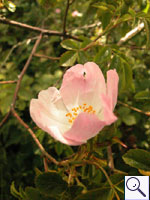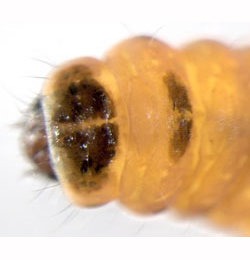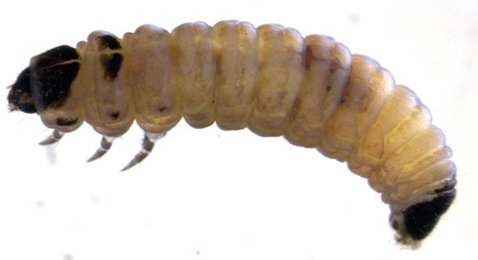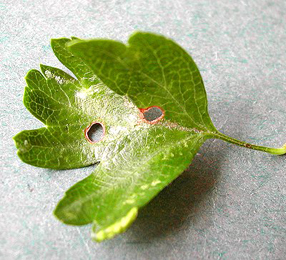|
||||||
ROSA. Roses. [Rosaceae] |
|
There are thirteen native species including Dog-rose (R. canina) and seven introduced species of Rosa recorded in Britain. Fourteen British miners are recorded on Rosa. A key to the European miners recorded on Rosa is provided in Bladmineerders van Europa. |
 Dog Rose Rosa canina |
Key for the identification of the known mines of British |
Note: Diptera larvae may live in a corridor mine, a corridor-blotch mine, or a blotch mine, but never in a case, a rolled or folded leaf, a tentiform mine or sandwiched between two more or less circular leaf sections in later instars. Pupation never in a cocoon. All mining Diptera larvae are leg-less maggots without a head capsule (see examples). They never have thoracic or abdominal legs. They do not have chewing mouthparts, although they do have a characteristic cephalo-pharyngeal skeleton (see examples), usually visible internally through the body wall. The larvae lie on their sides within the mine and use their pick-like mouthparts to feed on plant tissue. In some corridor miners frass may lie in two rows on alternate sides of the mine. In order to vacate the mine the fully grown larva cuts an exit slit, which is usually semi-circular (see Liriomyza huidobrensis video). The pupa is formed within the hardened last larval skin or puparium and as a result sheaths enclosing head appendages, wings and legs are not visible externally (see examples). See Key to non-Diptera. |
1a > Leaf-miner: Initially a linear mine which later develops into a conspicuous blotch; frass in two rows in linear section, scattered irregularly in the blotch (Spencer, 1976: 134-5, fig. 237, as potentillae). Corridor, gradually and considerably widening towards the end. Frass in two rows in the corridor part, further up dispersed irregularly. Pupation outside the mine. A short broad upper surface corridor leading to a long blotch between veins. |
|
Agromyza idaeiana (Hardy, 1853) [Diptera: Agromyzidae]. |
1b > Leaf-miner: Mine frequently starting along leaf margin, initially linear, later developing into an elongate blotch, frass in two distinct rows, even at end (Spencer, 1972b: 30, fig. 74; Spencer, 1976: 144, fig. 263A). First a long corridor, its initial part often along the leaf margin or a thick vein. Rather suddenly the corridor widens into a broad blotch. The corridor contains much, amorphous frass that sometimes seems to fill the entire corridor (lower picture). In the blotch the frass is in black strings and coarse lumps. (In rainy weather they liquify and loose their shape). Pupation outside the mine. A narrow upper surface gallery to start, then broadening and zigzagging to create a false blotch. |
|
Agromyza sulfuriceps Strobl, 1898 [Diptera: Agromyzidae]. |
Key for the identification of the known mines of British |
Note: The larvae of mining Coleoptera, Hymenoptera and Lepidoptera may live in a corridor mine, a corridor-blotch mine, a blotch mine, a case, a rolled or folded leaf, a tentiform mine or sandwiched between two more or less circular leaf sections in later instars. Larva may pupate in a silk cocoon. The larva may have six legs (although they may be reduced or absent), a head capsule and chewing mouthparts with opposable mandibles (see video of a gracillarid larva feeding). Larvae of Hymenoptera and Lepidoptera usually also have abdominal legs (see examples). Frass, if present, never in two rows. Unless feeding externally from within a case the larva usually vacates the mine by chewing an exit hole. Pupa with visible head appendages, wings and legs which lie in sheaths (see examples). |
1a > Leaf-miner and case-bearer: The larva lives outside the mine, protected by a case, and feeds on the underlying plant tissues via a hole cut in the epidermis. From that point it eats away as much leaf tissue as it can reach without fully entering the mine. Mine does not contain frass (Coleophora species) |
1b > Leaf-miner, but not a case-bearer: The larva lives mainly inside the mine. Mine usually contains frass. In later instars the larva may live sandwiched between two more or less circular sections cut from the leaf. |
2a > Leaf-miner and case-bearer: The larva feeds on rose, building successively larger portable cases from cut-out leaf fragments; September 3mm, October to April 6mm. In mid-April the third and final, 6 or 7 mm, case is formed. At first it is spatulate with a bivalved anal opening and serrate dorsal keel formed from a leaf margin. During May, the case is expanded dorsally, becoming cylindrical with a trivalved anal opening. The expansion may conceal the dorsal serration. The leaf damage and case are also illustrated in British leafminers. The larvae, which hatch around the end of August make three cases during their lifetime. The final one, which they occupy after the hibernation, is a laterally flattened tubular leaf case with a dorsal toothed keel (remnant of the leaf margin from which the cases was excised). Mouth angle about 60°. |
 Coleophora gryphipennella larva, dorsal Image: © Willem Ellis (Bladmineerders van Europa) |
|
Coleophora gryphipennella (Hübner, 1796) [Lepidoptera: Coleophoridae]. |
2b > Leaf-miner and case-bearer: The case resembles that of C. violacea, but does not lie so flat again the leaf as this species (having a mouth angle of 30 to 50°). C. violacea also has a case which bulges in the middle, whereas in C. potentillae the case tapers towards the posterior. Immediately after emergence the larva makes a full depth, quickly widening, corridor, with frass as small grains in a broad central band. Finally results a blotch of 2 x 5 mm, from which the youth case is cut. The fully developed case is a hairy, greyish brown to silver grey lobe case of about 1 cm long, with a clearly laterally compressed end; the mouth angle is about 90°. The case is difficult to separate from that of C. ochripennella. |
|
Coleophora potentillae (Elisha, 1885) [Lepidoptera: Coleophoridae]. |
2c > Leaf-miner and case-bearer: The larva feeds on a wide range of trees, shrubs and herbs, favouring Rosaceae, but not exclusively. The fully developed cased larva may be found active in October and again, after winter diapause, in April. Cases, about 6 mm, of diapausing larvae may be found through winter, fixed to a tree or fence post. The dorsal surface of the case is usually covered in leaf fragments, but they can sometimes be worn off almost smooth. The ventral surface is swollen at the middle and has a keel, which usually bends upwards at the posterior. The cases of C. ahenella (on Rhamnus, Frangula, Viburnum and Cornus) and C. potentillae (case less swollen, keel not bent up, resting position less prone) are very similar. Brownish lobe case that lies almost flat on the leaf, either on the upper or on the lower side. Case widest about the middle. Ventrally there is a distinct keel. Mouth angle 0°. Full depth mines rather large. The flaps of cuticular tissue that serve to enlarge the case are cut out of the upper epidermis. (contrary to C. ahenella and C. potentillae, that use tissue from the lower epidermis). The removal of these tissue flaps creates holes that are much larger than those that serve as the entrance to the mine. |
 Coleophora violacea larva, lateral Image: © Willem Ellis (Bladmineerders van Europa) |
|
Coleophora violaceae (Ström 1783) [Lepidoptera: Coleophoridae]. |
3a > Leaf-miner: Forms a blotch on the upper surface of the leaf, causing it to fold over. Whitish, upper-surface blotch, often occupying an entire leaflet. Fully developed mines strongly contract, and the leaflet doubles along the midrib. Almost all frass is ejected through a hole in the epidermis. Often several mines in a (composite) leaf. Pupation external. |
|
Coptotriche angusticollella (Duponchel, 1843) [Lepidoptera: Tischeriidae]. |
3b > Leaf-miner: A contorted gallery leading to blotch. Larva greenish-white with dark ventral spots. Oviposition at the underside of the leaf, usually not far from the midrib. The mine is a corridor; its first part is strongly contorted, intestine-like, containing brown, coiled, frass. The last part may follow the leaf margin for some distance. In the end the corridor widens into an elongate blotch with dispersed frass. The larva mines venter upwards. Pupation external. |
|
Ectoedemia angulifasciella (Stainton, 1849) [Lepidoptera: Nepticulidae]. |
| 3c > Leaf-miner: The larvae mine leaves at first, forming a blotch mine, later descending to the ground in a portable case and feeding on dead leaves. Oviposition is by way of an ovipositor, therefore no egg shell visible. The larva makes a small, roundish, blotch; often several in a leaf. Already after its first moult it makes an excision out of the mine, in size almost equal to the blotch (3-4 mm). Thus sandwiched it drops to the ground and continues feeding on dead leaf material. |
 Mines of Incurvaria masculella Image: © Rob Edmunds (British leafminers) |
|
Incurvaria masculella (Denis & Schiffermüller, 1775) [Lepidoptera: Incurvariidae]. |
3d > Leaf-miner: A circular or oval brownish blotch with a central spiral of dense blackish frass (British leafminers), sometimes several mines in one leaf. Oviposition is at the leaf underside, well away from the leaf margin; the egg has a fine reticulate surface. The mine is a rather large, perfectly circular blotch without a trace of a preceding corridor. Around the dark centre the frass, glued to the upper epidermis is arranged in distinct arcs. Pupation in a silken cocoon, usually on detritus. |
|
Leucoptera malifoliella (O. Costa, 1836) [Lepidoptera: Lyonetidae]. |
3e > Leaf-miner: A long, whitish smoothly-curved upper-surface mine with broken black frass. Oviposition is by means of an ovipositor; what remains is a small scar: no egg shell is visible at the start of the mine. From here a long, sometimes very long, slender, full depth corridor winds throught the leaf, not steered by leaf margin or the leaf venation. The midrib is crossed effortless; the corridor frequently also crosses itself; the section of the leaf cut off then usally turns brown and dies off. Frass in a narrow central line. The larva vacates the mine prior to pupation through an exit in the upper epidermis. The vacated larval chamber is proportionally much longer than in the case of Stigmella mines ( > 3 x longer than broad). Pupation in a silken cocoon suspended from threads attached to food plant or other vegetation. |
|
Lyonetia clerkella (Linnaeus, 1758) [Lepidoptera: Lyonetiidae]. |
3f > Leaf-miner: Before overwintering larvae make a small, full depth blotch (Robbins, 1991a). After hibernation, they live freely under a silk. Larvae mine in late autumn (Agassiz, 1996a). Not rare, in Belgium (De Prins, 1998a). |
|
Paraswammerdamia nebulella (Goeze, 1783) [Lepidoptera: Yponomeutidae]. |
3g > Leaf-miner: An early gallery filled with greenish frass, later leaving clear margins. Egg at the underside of the leaf, near a vein. The mine is a clear corridor, often with a hairpin turn, the section before the turn often following the leaf margin. The first section of the mine is entirely filled with greyish green frass. Further on the frass line is quite variable, black, sometimes coiled, always leaving a clear zone at either side. The shift in the frass pattern usually is quite sharp (probably coincides with a moult). The frass is deposited on the ceiling of the mine. Pupation external; exit slit in upper epidermis. |
|
Stigmella anomalella (Goeze, 1783) [Lepidoptera: Nepticulidae]. |
3h > Leaf-miner: A short gallery with linear frass. Egg usually at the underside of the leaf. The mine is a long sinuous gallery, often with a hairpin turn. Frass in a central line, leaving a clear zone at either side; this applies also to the first part of the corridor. Borkowski (1969a) stresses that the frass never is coiled. |
|
Stigmella centifoliella (Zeller, 1848) [Lepidoptera: Nepticulidae]. |
3i > Leaf-miner: Early gallery relatively straight with linear frass leaving clear narrow margins and not ending in a blotch. |
|
Stigmella spinosissimae (Waters, 1928) [Lepidoptera: Nepticulidae]. |
| Last updated 07-Jul-2019 Brian Pitkin | ||
